More about Thimbles





Magdalena and William Isbister.
To view many of the ‘Pictorial thimbles’ made by the thimble maker’s described below:
To determine the differences betweeen original and re-issued ‘Pictorial thimbles’ :
Introduction
My wife has been interested in thimbles since the early 1970s and I became interested as a result of buying thimbles for the collection during my many trips overseas to medical meetings and conferences. It became mandatory for me to learn something about the items that I was searching for and over the years, I became interested and a collector too! During the time of our collecting, we have managed to amass a modest number of French thimbles and we have spent many hours studying their markings and trying to identify their makers. The assay marks for French silver are well documented and will not be discussed further in this paper (1, 2).
Since the marking of French gold and silver, and thus thimbles, is ordered and precise and up until relatively recently, all small items of French gold and silver had to be marked, it would be not unreasonable thus to assume that it would have been an easy task to identify the maker of a particular French silver or gold thimble. Unfortunately, this was not our experience because often the mark was poorly stamped, it may have been rubbed and it was frequently unclear. More importantly when a master’s mark could be clearly seen we were unable to identify it because we were not able to find any reference guide to masters’ marks that covered the last century. We did find reference to a work detailing Parisian gold and silversmiths’ marks registered between 1798 and 1838 and which was published in France in 1991 (3). This work was reviewed in ‘’Thimble Notes and Queries’’ (4) and considered not to be of use to thimble collectors because it was expensive and the amount of information relevant to thimbles was limited. Those individual silversmiths and their marks that were mentioned as being thimble makers, however, were detailed. It is rather unlikely that thimble collectors today will find many thimbles from this early period (1798-1838) and so it seems to be a paradox that reference information exists for thimble makers’ marks which are unlikely to be found and no information is readily accessible for the marks most likely to be seen today.
Frank, in a TCI booklet (5), describes some of the 19th and 20th century French thimble makers and designers but details only one thimble maker’s mark. Many thimbles of the period are illustrated but there is no attempt to ascribe the thimbles to their makers.
We have searched the ‘net’ and asked many ‘experts’ in our quest to identify the marks and this short work outlines our findings. It is hoped that it may be of some value to those collectors who, like us, wish to know who made their French thimbles.
Thimble Making in France in the 19th and 20th centuries
Die Stamps
In 1798, and some time after the fall of the Bastille, new laws came into effect in France relating to the marking of gold and silver work. Under the new laws, all citizens who wished to work in gold or silver were required to possess a die stamp with which to mark their work. These stamps were authorized to those licensed to exercise the trade of goldsmith or silversmith and who could demonstrate that they were competent and of good morality (‘masters’). An impression of each die stamp was made on a copper plate and this together with details of the smith were lodged with the authorities. Only when the design had been approved could the mark be used. The mark consisted of the maker’s initials and a small distinctive emblem enclosed in a diamond shaped outline. The diamond shape denoted the purity of the fine metal. Legal degrees of fineness were established and in addition to the master’s mark, all assayed items were stamped with a hallmark, one for Paris and one for the provinces. From 1819, the marks were struck on an anvil or 'bigorne’ hence from this date French marks were two sided with the official assay office mark on one side and the bigorne design on the back. The latter is almost always impossible to see on a thimble. There was no system for dating the item as the assay offices were only concerned with collecting any dues owed and ensuring the fineness of the metal. All items had to be marked and it was not until 1956 that an exemption was made for small silver items weighing less than one gram. In 1972, this weight limit was raised to five grams (1).
All late 19th century and early 20th century French thimbles thus should have two marks – a diamond shaped master’s mark (poinçon de maître ou fabricant) and either a boar’s head (Paris (1838-1961)) or crab (provinces (1838-1961), (Paris and provinces after 1962) assay office mark (petit garantie) - and thus a thimble without any marks from this period is unlikely to be French.
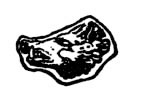

It has been our experience however that, despite the regulations described above, some French thimbles may be found without a master’s mark and this may be because the regulations regarding articles exempted from marking were rather complex. This can make the identification of the thimble maker even more difficult. Some thimbles with ornate rims do not seem to have a master’s mark either and this could be the manifestation of another exemption.
Thimble makers
Thimble collectors today pay much attention to the makers’ marks on British thimbles and this is facilitated by the hallmarking system in use in the United Kingdom. There seems to be little information in the ‘thimble literature’ however relating to masters’ marks to be found on 19th and 20th century French thimbles. It seems that the majority of late 19th and early 20th century French thimbles of gold or silver were made in Paris. The best contemporary source that we have discovered for late 19th century and early 20th century French gold and silversmiths’ marks is the French Ministry of Culture web site (6). All Parisian goldsmiths whose marks were registered between 1875 and 1914 are included and there are over 4000 registrations. Nineteen of the well known and not so well known Parisian ‘thimble makers’ from this time are to be found listed. Most of the workshops were rather close to each other and it would not be surprising if more than one workshop was involved in the final production or sale of a particular thimble.
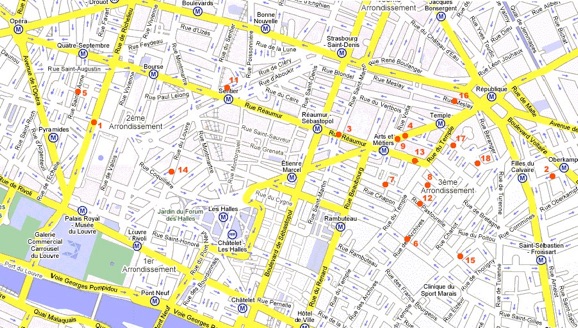
The thimble makers of the time mainly worked in the 2ème and 3ème Arrondissements:
1. Auguste Belleau, 43 rue de Richelieu.
2. Léon Chalin, 12 rue de Crussol.
3. Justin Levy Alekan, and later, Clément-Aubert 60 rue Turbigo.
4. Charles David, 64 rue Réaumur.
5. Charles Duchêne, 57 rue Sainte-Anne.
6. Charles Murat, 62 rue des Archives.
7. Jules Lorillon, 19 rue de Gravilliers.
8. René Lorillon, 4 rue Portefoin.
9. Alfred Féau, 59 rue de Turbigo, and later 4 rue Portefoin.
10. P. Genty, 31 quai du Halage, Crétiel*.
11. Henri Lambin, rue de Cléry
12. Jacob & Jules Lévy, 32-34 rue Pastourelle.
13. Jacob Lévy and his son Jean, 9 rue Réaumur.
14. Julien Duval, 17 rue du Louvre.
15. Ernest Prud’homme, 98 rue Vieille-du-Temple, and later 108 rue Amelot.
16. Louis Lenain, 11 rue Meslay.
17. Louis Lenain and son Philippe, 16 rue Dupetit-Thouars.
18. Philippe Lenain and son Roger, 32 rue Picardie.
19. Trans Pie, 78 rue Vaneau*.
*not on map
The history of thimble making in France, as it is known, has been detailed by Holmes and McConnel (7, 8). In the very late 19th century and the early part of the 20th century there were about five jewellers who made a significant number of thimbles in addition to other items of jewellery; Maison Lorillon, Maison A Féau, Maison Lévy, Maison Duval and Maison Prud’homme. Thimbles were seldom the main product of these workshops and thus many of the masters’ marks recorded may never be found on thimbles. Some masters bought thimbles from other workshops, for example, Philippe Lenain who had no interest in making thimbles himself (Roger Lenain, personal communication). The above goldsmiths’ master’s marks are all described today on the French Ministry of Culture site (6).
Maison Lorillon, Paris
Probably dates back to 1788 when Pierre Beniot Lorillon was accepted as a master goldsmith. By the mid 1850s, Lorillon was established as one of the leading gold and silver thimble manufacturers in the rue des Enfants Rouge. Cincinnatus, Jean Baptiste, Jules (19 rue de Gravilliers) and René Lorillon (rue Portefoin) all had their own marks but all except René are unlikely to be seen today.
Jules mark, ‘JL’ separated by a buffalo was first registered in 1862 and cancelled in 1875. The company then became Maison Féau (see below) until René assumed charge again in 1913.
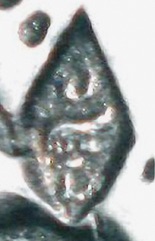
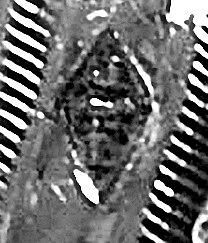
René’s mark was thus registered in 1913 and cancelled in 1917. It comprises the initials ‘RL’ separated by a buffalo:
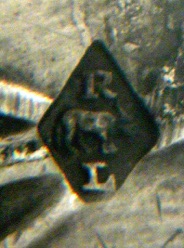
René Lorillon died in the First World War but his widow continued the business, using her husband’s mark between 1917 and 1927. According to her grandson, the mark ‘PL’ separated by a thimble (see below) was used by a manager working for René Lorillon’s widow.
Maison A Féau, Paris
According to Holmes (7) A. Féau (59 rue Turbigo) was the successor to an earlier company Maison Lorillon although which company was taken over by whom and how is not really clear. In one catalogue of thimbles thus, from the early 20th century the company address is 4 rue Portefoin and the name is ‘Anciennne Maison Lorillon - A. Féau’. In another catalogue from the same period, containing pictures of the La Fontaine Fable thimbles, the company is ‘Ancne. Mon. A. Féau – Lorillon’. The Lorillon company address was 4 rue Portefoin also at this time. It seems most likely, to us, that Alfred Féau took over the company from Jules Lorillon, of rue Turbigo, in 1875 and retained the buffalo in his first master’s mark. René Lorillon took the company back in 1913 and retained the buffalo symbol in his mark. This would seem to suggest that a family tie existed between the two families. The Lorillon/Féau companies were finally reunited in 1927 as " Le Dé à Coudre " and in 1950, the company manufactured in the Lenain Goldsmithery. By this time thimble production was declining and when Mrs. Plumont, the director of the company, retired, Roger Lenain who was trying to expand the Lenain business repurchased the company and gained all the old thimble dies from the Lorillon/Féau works (9).
Alfred Féau’s registered two marks. One ‘AF’ separated by a buffalo was registered in 1875 and cancelled in 1913. The other comprised the letters ‘AF’ separated by a thimble. This mark was registered in 1887 and also cancelled in 1913.
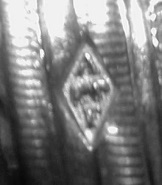
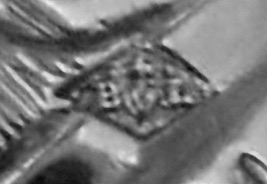
The ‘ Le Dé à Coudre’ mark was ‘BL’ separated by a heart surmounted by a cross. This was a revival of the old Baptist Lorillon’s mark (a known thimble maker of the time), which was discontinued in 1857.
Maison Lévy
It seems probable that the majority of French silver thimbles were made by the major houses and thimbles were marked with the house master’s mark. Sometimes other masters who either worked in the main house or in their own workshops ‘finished’ a thimble and then applied their mark. In this case, the thimble was made in the main house but may have been stamped with another master’s mark. Two such masters may have been from the Lévy family. Jacob and Jules Lévy of rue Pastourelle, Paris, registered their mark (a ladder) in 1884. Jacob then joined his son Jean in the rue Réaumur in 1888 and registered his mark ‘JL’ separated by a ladder. Jean seems to have adopted his father’s mark in 1908 but may have omitted the ‘JL’ according to the French Ministry of Culture site (6). It was cancelled in 1927. It would appear from the bill below, that Jean joined ‘ Le Dé à Coudre’ sometime before 1949 and before it was bought by Roger Lenain. As a result the Lévy dies became available for use by Roger Lenain also.
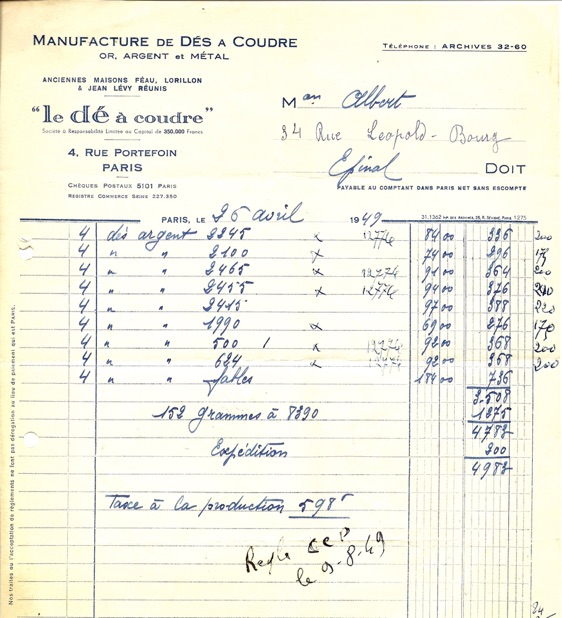
(c) Michel Painsonneau
Little more is known about the Maison Lévy and we have only seen their mark on thimbles made for export (see below).
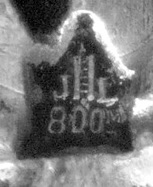

Maison Duval, Paris
In 1894 Julian Duval, rue du Louvre, a jeweller and medal maker, registered his mark and in 1935, the mark was cancelled. The mark comprised the letters ‘JD’ separated by a branch of mistletoe.

Maison Prud’homme, Paris
Ernest Prud’homme, rue Vieille-du-Temple, was a manufacturing jeweller in the rue Vieille-du-Temple and first registered his mark in 1891. The mark was cancelled in 1928 and comprised the letters ‘EP’ separated by a ‘caducee’. Later the company moved to 108 rue Amelot and the mark was modified to ‘SteP’ separated by a ‘caducee’:
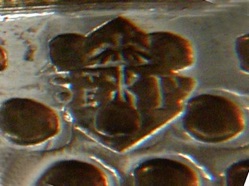
Maison Lenain, Paris
Louis Lenain, rue Meslay, registered his mark in 1906; it was re-registered in 1911 when he moved to rue Dupetit-Thouars and cancelled in 1920. It comprised two interlaced ‘L’s, one reversed. According to his grandson, Louis did not make thimbles and to our knowledge, his mark has not been found on a thimble.
Next the company became ‘Lenain et Fils ainé’, rue Dupetit-Thouars. The mark was ‘L& Fils’ with two interlaced ‘L’s, one reversed and it was registered in 1920. It is doubtful whether thimbles were made at this time either. In about 1925 Louis Lenain’s son Philippe took over the business and according to Philippe’s son, Roger, they bought thimbles from Lorillon/Féau. In 1929 the company became ‘Lenain Frères’, still at rue Dupetit-Thouars and the mark registered at this time was ‘LF’ separated by two interlaced ‘L’s, one reversed.
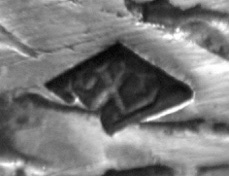
The company name changed again in 1938 when it became ‘Lenain et Cie’ of rue Dupetit-Thouars and later rue de Picardie. The mark remained the same. According to Roger Lenain, his father did not manufacture thimbles but concentrated on other forms of jewellery making. Roger worked in his father’s workshop until 1945.
It was later that Roger Lenain developed the thimble side of the business when he bought ‘ Le Dé à Coudre’ and gained access to all the old Lorillon/Féau dies.
It should be noted that there was another P. Lenain, who was unrelated, and who was an engraver (F Crestin-Billet, personal communication).
In the 1970s, Roger Lenain (Orfèvrerie Lenain) re-struck many of the Lorillon/Féau thimbles and marked them with Lenain et Cie’s mark. The re-struck de la Fontaine Fable thimbles for the foreign market, for example, thus had the Lenain et Cie master’s mark and in addition, they had a numerical finger size, the word ‘France’ and the Mercury head export assay mark (the size number and ‘France’ were omitted from re-issues destined for the domestic market and a crab replaced the Mercury head).
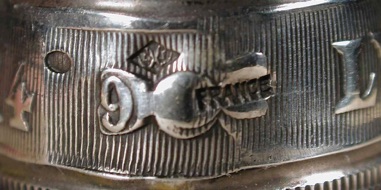
These re-issued thimbles were attributed to P Lenain & Co. by von Hoelle (10) who also incorrectly described the ‘touchmark’ as ‘a diamond with an L and an F separated by a large X with the diamond.’ It is probably this description that has been responsible for the widely held view that the de la Fontaine Fable thimbles were first made by P Lenain & Co. It would seem now, however, that the original dies for these thimbles were of Lorillon origin from the end of the 19th century and that they were purchased and re-issued by Roger Lenain about 60 years later.
In the 1980s, Roger Lenain was himself bought out and thimble production finally ceased in the Lorillon/Féau/Lenain workshops.
Other masters’ marks
AB

The mark illustrated above has been found on a thimble. AB separated by the letter O ‘crowned’ belongs to Auguste Belleau of the rue de Richelieu. The mark was registered in 1880 and discontinued in 1881.
CA

This mark belongs to Clément-Aubert of 60 rue Turbigo, Paris. The mark, CA separated by a lyre, was registered in 1893 and discontinued in 1896. Clément-Aubert probably succeeded Justin Levy Alekan (see below) at number 60 and finished thimbles for Maison Féau his next-door neighbour.
CD

The mark ‘CD’ separated by an oak leaf belongs to Charles Duchêne of rue Sainte-Anne. The mark was registered in 1912. The mark ‘CD’ separated by a fox on his back belonged to Charles David of rue Réaumur and was registered in 1894. It is difficult to be certain whether the symbol represents a fox or a leaf but rue Réaumur is situated in the ‘thimble making’ district of Paris and rue Sainte-Anne is quite a long way away so that it seems more likely that the mark above is that of Charles David.
CM

This mark belongs to Charles Murat, CM separated by a blackberry with two leaves, and was registered in 1897. Maison Murat was situated on the rue des Archives in Paris and the mark has been found on thimbles.
HL
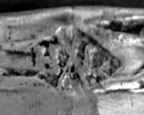
This mark probably belongs to Henri Lambin of 17 rue de Cléry. The mark, ‘HL’ separated by two crossed ears of corn, was registered in 1909 and cancelled in 1936
LA

Justin Levy Alekan worked in the rue Turbigo and registered his mark ‘LA’ separated by a star and double heart in 1882. It was cancelled in 1893. It seems likely that he finished thimbles from Maison A Féau.
LC
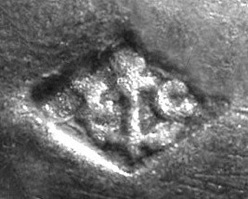
This mark, ‘LC’ separated by an anchor was registered by Léon Chalin, rue de Crussol, Paris in 1885 and cancelled in 1929. This mark has been found on thimbles (11). Léon Chalin was one of the very few thimble makers of the time who stamped their thimbles with a size number.
PG

This mark, ‘PG’ separated by a hand mirror, possibly belongs to a P. Genty. A similar mark was registered by Edmond Genty (‘EG’ separated by a hand mirror) of 31 quai de Halage a Crétiel in 1912 and cancelled two years later. It is quite possible that his son continued working on the same premises with the above mark.
PL
We have been unable to find or identify any mark registered for a ‘Pierre’ Lenain’ although, by law, had a ‘Pierre’ Lenain been making silver thimbles he would have been required to register a mark. The marks below, PL separated by a thimble, have been found on early 20th century thimbles but we have been unable to trace, authenticate or find any evidence of the registration of the marks. In spite of much research, the service of the guarantees of Paris was not able to find any trace of the mark in its many files either.
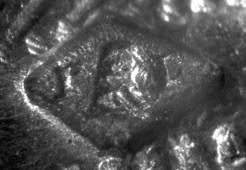
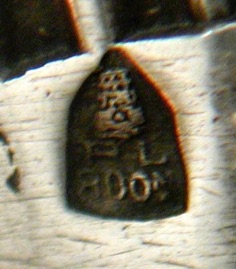
It has been claimed that these marks are the marks of ‘Pierre Lenain’ but this is clearly impossible (12). They seem most likely to be ‘Lorillon’ marks because they have been found on de la Fontaine Fable thimbles of the early 20th century that were identical to those known to have been made by Lorillon. They have also been seen on other thimbles to be seen in a Lorillon catalogue of the time. There was often marriage between thimble making families and it is known that the Lorillon/Féau families were close and in fact merged their workshops to form ‘Le Dé a Coudre’ in 1927. When unions of this type occurred, in the same place and around the same time of registration symbols in masters’ marks were often preserved. A buffalo was thus used by J Lorillon and then A Féau and finally by R Lorillon. A Féau also used the thimble emblem. It would thus not be surprising for a Lorillon to use a thimble in his mark too. René Lorillon died at an early age (24 years) in the Great War and although he did have a son called Pierre, we do not think that the mark belonged to him. Pierre was too young and not a goldsmith. It is proposed that Louis Plumont was the probable owner of this mark.
Louis Plumont was a goldsmith and collaborator of René Lorillon and on René’s death took charge of the workshop under the direction of René Lorillon’s wife. When “Le Dé a Coudre” was created, Louis Plumont’s wife became manager. Plumont thus had access to the Lorillon dies and it is not surprising, therefore, to find similar thimbles with either R.L. (Lorillon) or P.L. (Plumont).
Louis Plumont was a manufacturer of thimbles in his own right. He was also an impassioned collector of paintings and was a patron of Conrad Kickert, the Dutch painter of Montparnasse. On the recommendation of the director of the Visconti gallery, Kickert was invited to exhibit at the ‘salon de la Folle Enchère’, in November 1923, and there he sold “Le Chêne de l’Enclos”, N° 89, in the catalogue to Mr. Louis Plumont, a ‘’manufacturer of thimbles who lived in Cormeilles-in-Parisis’’ on the outskirts of Paris (13). In June of the same year Kickert stayed with Plumont in Cormeilles-in-Parisis and the families became friends.
One might expect that the mark for Louis Plumont would be ‘LP’ separated by a thimble however the mark is actually ‘PL’ separated by a thimble. It is possible that LP represents Plumont Louis, but it seems more likely to represent Plumont - Lorillon because the owner of the workshop at the time was René Lorillon’s widow. The emblem, the thimble, is one of the emblems found in early marks of the Maison Féau, predecessor of Lorillon (14).
PT

This mark, PT separated by a tiara, almost certainly belongs to Trans Pie of rue Vaneau and it was registered in 1882.
Other marks sometimes found on thimbles of the period
Obus
In addition to assay office export marks, for example the Mercury head found on the re-struck La Fontaine Fable thimbles and signifying that the thimble is of legal standard of fineness to be exported, the ‘Obus’ (cannon shell) mark, in use since 1884, was struck by the maker on articles of low silver quality which were to be exported. The Obus contained the master’s mark and the letter M or K indicating fineness:
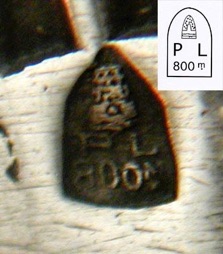
The Obus mark was not usually associated with any other mark since both the maker and the degree of fineness of the silver were contained within the same mark.
Size mark
After about 1920, at least one master (Léon Chalin) marked his thimbles with a size number in addition to the two usual marks. Size marks were added by Roger Lenain (Orfèvrerie Lenain) when he re-struck many of original the Lorillon/Féau thimbles for export in the 1970s (see above). Size numbers do not seem to have been punched on re-issues of the same thimbles manufactured for the French market.
Signature of designer/engraver
The name of the designer/engraver is sometimes found on a thimble above the rim although not all thimbles designed by a particular designer will bear his name.
Frédéric Charles de Vernon (1858-1912) designed thimbles for Maison Duval and his name ‘F. Vernon’ is to be seen on some thimbles.
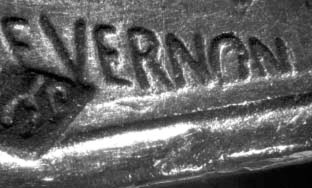
Firmin-Pierre Lasserre (1867-1930) usually signed his designs ’FP Lasserre’ but sometimes either ‘LAS’ or ‘RRE’ or ‘LASS ERRE’ may be found.
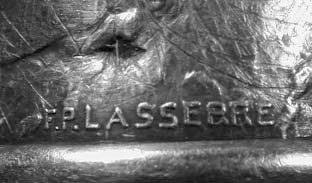
The best-known illustrator of Art Nouveau thimbles is probably George Goursat (1863-1934). He worked closely with Maisons Lorillon and Féau and signed his work ‘Sem’, ‘Sem G’ or ‘S.G.’

A rare name on thimbles is Pierre Charles Lenoir. He was born in Paris in 1879 and died in 1953. He was a pupil of his father Charles Lenoir who was a sculptor. He studied under Chaplain, Peter, Rot and Mercier. From 1899 Lenoir exhibited regularly at the Salon des Artistes François and was awarded second-class medals in 1905 and 1907. He became Chevalier of the Legion of Honour and was awarded the Croix de Guerre. Lenoir executed numerous war memorials and statues, for example in the Petit Palais in Paris. His name appears on medals and the occasional thimble.
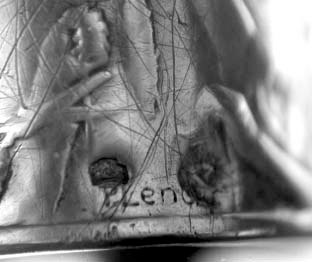
Conclusion
It is probable that there are indeed more masters’ marks on French thimbles from the period in question but they are not likely to be seen very often and we have not come across any so far.
In 1992 Holmes wrote ‘’I have known the La Fontaine fables all my life, they were part of my youth, and I would love to own the thimbles if only I could be sure of having the genuine article. Unfortunately,… ..., I no longer know which is which. You need to be an expert in French thimbles these days to collect them and I am not confident enough to risk it.’’ (15).
Whilst it cannot be claimed that this review is complete or that we are ‘experts’ it is hoped that it will be of assistance to those thimble collectors that are as confused as we were with regard to French thimble makers and their marks and that they will be confident enough to take a few risks with French thimbles in the future. In particular, it is hoped that the role attributed to Pierre Lenain in relation to the La Fontaine Fable and Grimm Brothers’ Fairy Tale thimbles has been clarified once and for all. It is also hoped that those collectors who know much more about French thimbles than we do will now come forward and document more makers and their marks.
Acknowledgements:
We are especially thankful to the people listed below who responded promptly to our many questions:
Ghislaine Chaplier who answered many, many emails and relayed information from Monsieur Roger Lenain.
Michel Painsonneau who shared his knowledge of French thimble making history with us, who managed to get information from the Chef de la Cellule Technique de Garantie de Paris (Bureau of Garantie of Paris, Bureau of Customs, Paris), who was able to contact the grandson of René Lorillon and who made available to us the bill from Le Dé à Coudre .
Wolf-Dieter Scholz who made his vast library of references available to us.
Ray Nimmo who gave permission to use his pictures of the ‘AB’ and ‘LA’ marks and who meticulously checked the manuscript.
References:
1. Tardy International Hallmarks on Silver, 1985. 5th Edition, 2000.
2. Poinçon d’États. Available from:
http://www.alienor.org/Articles/poincons_Etat/chronologie.htm#1838
3. Arminjon C, Beaupuis J & Bilimoff M. Dictionnaire des poinçons de fabricants d’ouvrages d'or et d'argent Paris 1798-1838. Paris, Imprimerie National, 1991.
4. Holmes EF. Paris gold and silver thimble makers 1798-1838. Thimble notes and queries 1993; 19: 10.
5. Frank B. Thimbles of France with waffled knurling. Thimble Collectors International. USA. 2003.
6. Palissy base. Available from:
http://www.culture.gouv.fr/public/mistral/marque_fr?ACTION=RETOUR
&USRNAME=nobody&USRPWD=4%24%2534P
7. Holmes EF. A history of thimbles. London: Cornwall Books, 1985. pp. 69.
8. McConnel B. The story of the thimble. Atglen, PA.: Schiffer Publishing Ltd, 1997. pp. 113.
9. Crestin-Billet F. Ouvrages de dames. Paris Tana, 2005. pp. 67-77.
10. von Hoelle JJ. Thimble collector’s encyclopedia. Illinois: Wallace-Homestead Book Company, 1986. pp. 134.
11. Forum. TCI Bulletin 1992; summer: 14
12. Mohr G. Günter Mohr stellt Sammler vor (2). Rund um den Fingerhut 1989; 10:19.
13. Association Conrad Kickert, Pleaux, France. Conrad Kickert . Le peintre hollandais de Montparnasse. Available from :
14. Isbister M, Isbister W, Painsonneau M. Thimble Society Magazine, 2007; 9 (17): 5.
-
15. Holmes EF. Thimble rigging. Thimble notes and queries 1992; 15: 7.
Holmes: ‘Thimbles in France’ pp. 65.
Addendum (9/2011)
As additional thimble makers’ marks become known they will be added here:
JQ
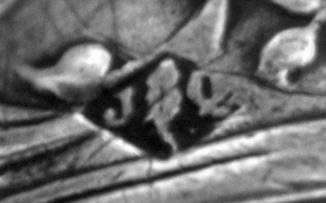
This mark, JQ separated by an oak leaf, belongs to Janvier Quercia of 176 rue Saint-Martin and later 4 passage de la Reunion, both in the 3ème Arrondissement. The mark was first registered in 1899 and cancelled in 1936.
Lorillon
Several members of the Lorillon family were silver and goldsmiths in the 19th century (1, 2). Unfortunately it is not known whether they ever made thimbles. One new mark has recently been found on a thimble and we are grateful to Carolyn Meacham for allowing us to use her image.
BL
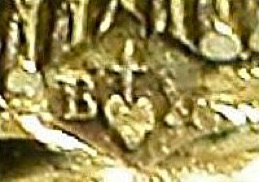
The mark BL separated by a heart with a cross above it and a point on each side, belongs to Baptiste Lorillon of 6 rue des Enfants-Rouges (now called rue des Bons Enfants). He seems to have already called his company ‘Le dé à coudre’, so was clearly a thimble maker and when the Lorillon/Féau families united in 1927 this name was continued as the name of the joint company. Baptiste Lorillon’s mark was registered in 1854 and cancelled in 1857. We presume that Baptiste was Jules Lorillon’s father.
Baptiste Lorillon’s father, Jean-Baptiste Lorillon’s mark was similar to his son’s mark but seems to have been contained within both diamond and a rectangular outlines.
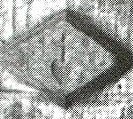
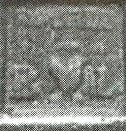
These marks were variously registered from 1839 to 1851 and finally cancelled in 1854. To date there is no evidence that Jean-Baptiste made thimbles and he was listed as a jeweller.
CL
Cincinnatus Lorillon, probably Jean-Baptiste’s father, another member of the family of jewellers was a spoon-maker and small-worker. He registered his mark, CL separated by a rising sun above a star, in the second decade of the 19th century.

Cincinnatus, Jean-Baptiste and Baptiste successively worked at 239 rue St Martin, 3 rue de la Croix St Martin, 6 rue Bar-du-Bec, 3 rue Geoffroy-l’Angevin, 66 rue Rambuteau, and finally 6 rue des Enfants-Rouge.
PBL
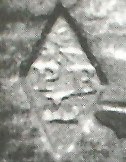
This mark, PBL below a rising sun, belongs to Pierre-Benoit Lorillon and was first registered in 1788. It seems to have been in use until 1810. It is not known whether Pierre-Benoit made thimbles, he was a goldsmith at 181 rue St-Martin.
References
1. Arminjon C, Beaupuis F & Bilimoff M. Dictionnaire des poincons de fabricants d'ouvrages d'or et d'argent de Paris et de la Seine, 1798-1838. Paris. Imprimerie nationale, 1991.
-
2.Catherine Arminjon, James Beaupuis & Michèle Bilimoff. Dictionnaire des poincons de fabricants d'ouvrages d'or et d'argent de Paris 1838-1879. . Paris. Imprimerie nationale, 1991.
We are grateful to Carolyn Meacham for bringing another French thimble makers mark to our attention. The mark was found on an early 19th century gold thimble and would have been outside of our remit in our original booklet. Since French thimble makers‘ marks are generally difficult to identify we have decided to include any French thimble maker’s marks that are new to us in the addendum.
Q
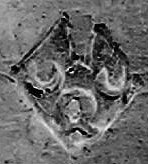

This mark, a goblet between two croissants surmounting the letter ‘Q’ belongs to Quinet Etienne-Alexandre of 2 rue des Boucheries-St Honoré and was registered in 1803.
Addendum 2015
BF & Cie

This mark found recently on a thimble by Kelvin Hopkins, BF & Cie and a fleur de lys, was first registered in 1918 and belongs to Bardies, Faure and Company of 13 rue des Fontaines-du-Temple.

Researched and published in 2002/11
Copyright@2011. All Rights Reserved
Magdalena and William Isbister, Moosbach, Germany
Late 19th and early 20th century French silver thimble makers’ marks
Navigation
